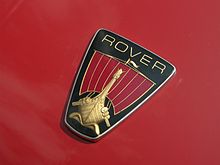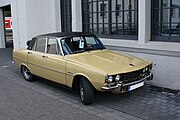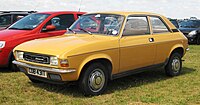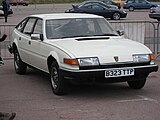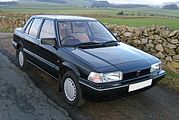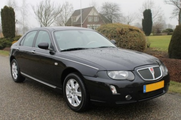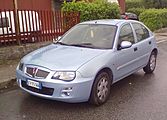Rover (automobile manufacturer)
| Rover Company Limited
|
|
|---|---|
| legal form | Limited Company |
| founding | June 13, 1896 |
| resolution | 2005 |
| Seat |
Longbridge , West Midlands , United Kingdom |
| Branch | Automobile manufacturer |
Rover was a British automobile manufacturer based in Longbridge . The Indian automobile manufacturer Tata has owned the trademark rights since 2008 .
1884–1967: company history
The first Rover was a three-wheeler manufactured by JK Starley & Sutton Co in Coventry , UK in 1884. The company was very innovative in the field of bicycles and produced a. a. also the Starley Safety Bicycle , a three-wheeled bicycle in which the single wheel driven by a chain was attached to the rear. Compared to the high bikes customary at the time , it was considered very safe and soon found widespread use; so that, for example, the word rower was adopted in Polish as a name for bicycle .
In 1888 a prototype of an electrically powered vehicle was created, but it was never mass-produced. In 1896 the company was renamed the Rover Cycle Company .
In 1902 the first Rover motorcycle was built, the Imperial Rover Motor Cycle with 2.25 HP. it was followed in 1911 by a 3.5 HP machine, a 5/6 HP twin, a 250 cm³ lightweight and a 350 cm³, with which one successfully participated in many races. In 1904 the first automobile was produced, a two-seater named Rover Eight . This car proved its reliability on a trip from London to Constantinople . In 1906 the company was renamed The Rover Company Limited .
In the years up to 1907 the 16/20 HP, the 10/12 HP and a 12 HP followed. A 20 HP won the Isle of Man Tourist Trophy in 1907 . In the course of the Great Depression , the production of motorcycles and bicycles was stopped in 1923 and the company was renamed Rover .
The air-cooled 8 HP two-cylinder was developed after 1918, and 17,000 of them were sold within five years. The Rover 14/45-HP came onto the market in 1925. In 1930, a Rover Light-Six raced against the Train Bleu , a famous express train on the St. Raphael - Calais route, and won by 20 minutes. Several four- and six-cylinder models were produced by 1936.
After the Second World War , steel was subject to quotas and was therefore only available to companies that could show exports . For this reason, the company began in 1947 with the production of the Land Rover , a versatile all-terrain vehicle with all-wheel drive , which was originally intended for agriculture; To save steel, the structure was made of sheet aluminum riveted to a tubular steel frame. This Land Rover quickly became a bestseller.
As early as the late 1940s, the company began to experiment with gas turbines as a drive and developed prototypes ; in 1950 the JET-1 was presented. In the years 1953 to 1961 further prototypes with gas turbines were developed. In 1963, a 150 hp gas turbine was built into a BRM racing car, and it was used to start the Le Mans 24-hour race . The car crossed the finish line at an average speed of 173 km / h.
In 1949 the new Rover 60 with four-cylinder engine and the Rover 75 with six cylinders appeared. From 1958 the "middle class Rolls-Royce" P5 was built, a coupé and a sedan with a three-liter six-cylinder engine and from 1967 with a V-8 engine and 3.5 liter displacement (P5B). These vehicles were able to establish themselves well in the upper middle class segment . Finally, the Range Rover came on the market.
In 1965 Rover merged with Alvis Limited , in 1967 the merger with Leyland Motor Corporation took place.
1967-1982: British Leyland
In 1967 Rover became part of the Leyland Motor Company, which with the British Motor Corporation (BMC) became the British Leyland Motor Corporation , or British Leyland for short . From 1972 the group was called Rover-British Leyland UK Limited .
Rover was just one brand among many in a huge conglomerate of different companies such as Austin , Jaguar , Morris , MG , Triumph , Wolseley , Leyland Motors (commercial vehicles) and others. This marked the end of Rover's time as an independent company, and from then on the British auto industry began to decline.
Symptomatic of this era was the Rover SD1 hatchback sedan presented in mid-1976 , an excellent car in itself, but which, due to glaring manufacturing and quality defects, could never shed its bad reputation. In the same year British Leyland went bankrupt and was nationalized. Even the version of the large Rover model, known as Vitesse from 1983 onwards , which even won international automobile awards due to its modern design, could no longer hold back development. The Land Rover and Range Rover SUVs alone still had a very large following, including a. as towing vehicles for caravans .
1982–1994: privatization
In the early 1980s, a cooperation with Honda came about, under which a number of vehicles were jointly developed. Honda also acquired a 20 percent minority stake in Rover. The company was renamed the Austin Rover Group in 1982 .
After Jaguar was spun off in 1984, it used the name Rover Group again from 1988 . At this time the Rover 400 ( Honda Civic ) and 600 ( Honda Accord ) based on Honda models as well as the Rover 200 , the first completely newly developed model in a long time, were created. The top model 800 , which appeared in the fall of 1986, was also still on offer, as was the old Mini (formerly bearing the Austin emblem) .
1994–2000: takeover by BMW
In 1994, Austin Rover was taken over by the BMW group. After a restructuring of the type names, the models 75 (a new development), 25 (based on the 200) and the 45 (still based on the Honda 400) appeared from the beginning of 1999 .
Because of the known problems between BMW and Rover when the Rover 75 was presented and the resulting uncertainty about Rover's future, he was unable to achieve the sales figures he was aiming for. The takeover by BMW also ended the long-term development cooperation with Honda, which had also had high hopes for the takeover of the Rover Group . In addition, the mid-engined MG F roadster presented in autumn 1995 was also produced.
2000-2005: MG Rover Group
When at the beginning of 1999 a profitable development did not appear foreseeable even after investments of almost 4 billion EUR, the responsible CEO Bernd Pischetsrieder from BMW had to vacate his post. As a result, Chief Technology Officer Wolfgang Reitzle also left the company. In 2000, Rover was spun off from the BMW Group. The Land Rover off-road vehicle brand came to the Ford Group, while the almost completely developed new Mini remained with BMW. Mini could be established as a separate brand; the model range has been expanded.
The owner of the remaining Rover Group became the Phoenix-Venture Group , consisting of four business people from Birmingham, who took over Rover from BMW for the symbolic sum of 10 pounds due to lack of further interested parties. BMW granted the new management a long-term, interest-free loan of 500 million pounds. However, MG Rover had to buy the powertrain engine division from the BMW Group in return. The company MG Rover Group was named in the hope of being able to arouse greater interest in the automobile market with the “sporty” MG brand .
Particularly sporty models were subsequently given the traditional name MG, such as the MG ZT 260 based on the Rover 75 with a 4.6-liter V8 engine with 191 kW (260 hp) purchased from Ford. A super sports car called MG SV-R , based on the Qvale Mangusta , was only built 50 times.
2005: The second downfall
In 2004, Rover produced 100,000 cars with 6,000 employees at the Longbridge plant (1999: 225,000). That was less than half the capacity needed to break even. In the same year negotiations were held on a joint venture with the Chinese Shanghai Automotive Industry Corporation (SAIC). SAIC wanted to invest 1.5 billion euros in a company to be founded together with Rover, including for the development of new vehicle models. The conclusion of the contract in 2005 is expected once the approval of the Chinese government has been received. Ultimately, however, the negotiations failed due to MG Rover's unsecured liquidity, although the British government promised a subsidy of 100 million pounds. The MG Rover Group then had to file for bankruptcy on April 7, 2005 as the last remaining mass car manufacturer in British ownership. Phoenix Venture Holdings (PVH), as the owner of the British car manufacturer, offered a sum of 71 million euros in the form of cash, shares and property values (for example, Studley Castle in Warwickshire, Central England, valued at twelve million euros ) in order to save the company to enable.
PVH boss John Towers said: "All of PVH's possessions are available to help the bankruptcy trustee find a buyer!" The 71 million should go to a foundation, whose holdings should benefit the families of the employees if the rescue would fail. Although Rover never got out of the red in the past few years, the management of Phoenix Venture Holding regularly enjoyed high bonus payments. In 2003, for example, Rover posted a loss of 133 million euros, but the five board members around John Towers together had an annual income of 24 million euros. A year earlier (2002) Rover posted a loss of 140 million euros; Nevertheless, the Phoenix members received a "bonus" of 19 million euros. There was severe public criticism. The British House of Commons eventually recommended the appointment of an independent board chairman to restore the confidence of workers and the public. That advice was followed at Phoenix.
MG Rover's racing division, MG Sport and Racing Limited (MGSR), was to be sold separately as an independent company within the MG Rover Group. The racing project in the DTM and the construction of the MG SVR sports car should be continued by the 48 employees of the MGSR. Despite the cancellation, SAIC did not rule out new talks, but it should be seen what would be left on Rover's balance sheet as assets after the bankruptcy proceedings were concluded.
In July 2005, the assets of MG Rover and those of a subsidiary, the engine manufacturer Powertrain Ltd., were taken over by the Chinese group Nanjing Automobile Corporation for more than 50 million pounds (around 73 million euros) .
In March 2006, Nanjing announced that MG Rover models would be sold in the UK and Spain from early 2007. The reason for this was Rover's strong sales recently in these markets. Initially, a revised MG TF and the MG 7 , a completely revised variant of the MG ZT, should be offered . At the end of 2007 the MG 5 was to follow as the successor to the Rover 45 .
In September 2006, BMW sold the naming rights to Rover to the Ford Group. The Rover brand licenses went to the Chinese Shanghai Automotive Industrial Corporation (SAIC) for over 16 million euros, as SAIC had already secured the design rights to the Rover models 25 and 75. The Ford Group, however, had already taken over the Land Rover brand in 2000 and secured the right of first refusal for Rover .
In March 2008, Tata Motors acquired the trademark rights to the Rover brand from Ford with the purchase of Jaguar and Land Rover, in addition to the trademark rights to Daimler Motor Company and Lanchester Motor Company .
SAIC is therefore bringing the planned new models to the Asian market and to other markets under MG under the similar-sounding brand name Roewe .
Models
1904-1940
| Type | Construction period | Cylinder / valve control | Displacement | power |
|---|---|---|---|---|
| Rover 6 | 1906-1912 | 1 / sv | 780-812 cc | 6 bhp (4 kW) |
| Rover 6/21 | 1923 | 6 / sv | 3446 cc | |
| Rover 8 | 1904-1912, 1919-1924 | 1-2 / sv | 998-1327 cc | 8–13 bhp (6–9.5 kW) |
| Rover 9/20 | 1924-1927 | 4 / ohv | 1074 cc | 20 bhp (15 kW) |
| Rover 10 | 1934-1940 | 4 / ohv | 1389 cc | 44 bhp (32 kW) |
| Rover 10-12 | 1906-1907 | 4 / sv | 1767 cc | |
| Rover 10/25 | 1928-1933 | 4 / ohv | 1185 cc | 25-27 bhp (18-20 kW) |
| Rover 12 | 1909-1915, 1934-1940 | 2-4 / ohv | 1496-2297 cc | 12–48 bhp (9–35 kW) |
| Rover 12/14 | 1912-1925 | 4 / sv | 2297 cc | 28 bhp (21 kW) |
| Rover 14 | 1933-1940 | 6 / ohv | 1577-1901 cc | 54 bhp (40 kW) |
| Rover 14/45 | 1924-1928 | 4 / ohc | 2132 cc | 45 bhp (33 kW) |
| Rover 15 | 1909-1911 | 4 / sv | 2488 cc | |
| Rover 16 | 1927-1932, 1937-1940 | 6 / ohv | 2023-2147 cc | |
| Rover 16-20 | 1906-1907 | 4 / sv | 3119 cc | |
| Rover 16/50 | 1926-1929 | 4 / ohc | 2413 cc | 50 bhp (37 kW) |
| Rover 18 | 1912-1913 | 4 / sv | 3307 cc | 35 bhp (25.7 kW) |
| Rover 20 | 1908-1910, 1931, 1939-1940 | 4-6 / sv + ohv | 2512-3251 cc | |
| Rover Knight | 1911-1912 | 1 / slider | 1389 cc | 9 bhp (6.6 kW) |
| Rover Meteor 16 | 1933 | 6 / ohv | 2022 cc | 45 bhp (33 kW) |
| Rover Meteor 20 | 1931-1933 | 6 / ohv | 2565 cc | 60 bhp (44 kW) |
| Rover Pilot 12 | 1932 | 6 / ohv | 1410 cc | 30 bhp (22 kW) |
| Rover pilot 14 | 1932 | 6 / ohv | 1577 cc | 35 bhp (26 kW) |
| Rover Speed 14 | 1934-1935 | 6 / ohv | 1577 cc | 54 bhp (40 kW) |
| Rover Speed 16 | 1934-1935 | 4 / ohv | 2023 cc | |
| Rover Speed 20 | 1934-1935, 1937-1940 | 6 / ohv | 2512-2565 cc | 72 bhp (53 kW) |
| Rover Speed Pilot | 1933 | 6 / ohv | 1577 cc | 44 bhp (32 kW) |
1945-2005
| Type | Construction period | Cylinder / valve control | Displacement | power |
|---|---|---|---|---|
| Rover 10 | 1945-1948 | 4 / ohv | 1389 cc | 44 bhp (32 kW) |
| Rover 12 | 1945-1948 | 4 / ohv | 1496 cc | 48 bhp (35 kW) |
| Rover 14 | 1945-1948 | 6 / ohv | 1901 cm³ | 54 bhp (40 kW) |
| Rover 16 | 1945-1948 | 6 / ohv | 2147 cc | |
| Rover 25 | 1999-2005 | 4 / ohc | 1400-2000 cc | 84–145 bhp (62–107 kW) |
| Rover 45 | 1999-2005 | 4-6 / ohc | 1400-2000 cc | 103-150 bhp (76-110 kW) |
| Rover 75 | 1998-2005 | 4-8 / ohc | 1800-4600 cc | 120–260 bhp (88–191 kW) |
| Rover 100 series | 1990-1998 | 4 / ohc | 1100-1500 cc | 60-103 bhp (44-76 kW) |
| Rover 200 series | 1984-1999 | 4 / ohc | 1100-2000 cc | 60–200 bhp (44–147 kW) |
| Rover 400 series | 1990-1999 | 4 / ohc | 1400-2000 cc | 103-136 bhp (76-100 kW) |
| Rover 600 series | 1993-1999 | 4 / ohc | 1800-2300 cc | 105-200 bhp (85-147 kW) |
| Rover 800 series | 1986-1999 | 4-6 / ohc | 2000-2700 cc | 120-200 bhp (88-147 kW) |
| Rover-Alvis P6-BS | 1967 | 8 / ohv | 3528 cc | 150 bhp (110 kW) |
| City Rover | 2003-2005 | 4 / ohc | 1400 cc | 84 bhp (62 kW) |
| Rover gas turbine vehicles | 1947-1965 | Gas turbine | 100–230 bhp (74–169 kW) | |
| Rover Metro | 1980-1994 | 4-6 / ohc | 998-2991 cc | |
| Rover MI | 1947 | 4 / oise | 699 cc | 28 bhp (20.6 kW) |
| Rover P3 | 1948-1949 | 4-6 / oise | 1595-2103 cc | 51–72 bhp (37.5–53 kW) |
| Rover P4 | 1949-1964 | 4-6 / oise + ohv | 1997-2639 cc | 60–123 bhp (44–90.5 kW) |
| Rover P5 | 1958-1973 | 6-8 / oise + ohv | 2995-3528 cc | 128–145 bhp (94–105 kW) |
| Rover P6 | 1963-1977 | 4-8 / ohc + ohv | 1978-3528 cc | 120–145 bhp (88–105 kW) |
| Rover SD1 | 1976-1986 | 4–8 / ohc / ohv & ohv | 2000,2300,2600 & 3528 cc | |
| Rover Streetwise | 2003-2005 | 4 / ohc | 1400-2000 cc | 84–145 bhp (62–105 kW) |
Timeline
Web links
Individual evidence
- ^ The Rover Company Limited . Companies House . Retrieved June 19, 2014.
- ↑ autoblog.com: Tata buys 5 British marques for the price of 2 (English) from March 28, 2008

